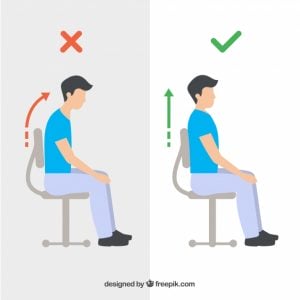 Are you sitting at work a lot? Your armchair and desk are not adapted to your figure? Are you starting to slouch? Does your back hurt?
Are you sitting at work a lot? Your armchair and desk are not adapted to your figure? Are you starting to slouch? Does your back hurt?
What are round backs and what you can do about it – you will learn articles from it!
The round back is characterised by too intense work of the pectoral muscles larger along with the widest back. This causes the “closing” of the superficial tape of the upper limbs and the internal rotation of the humerus.
Most everyday activities and exercises are based on the internal rotation of the shoulder joints. Our body ‘builds’ a network of collagen fibers to strengthen a given motion vector. The result is a disorder of the myofascial balance between the chains in front of the body and their antagonists. We create a postural pattern that, with its presence, not only affects the decentralisation of the humerus in the acetabulum and the load on the neck muscles, but also many other aspects from the curvature of the spine to the breathing pattern.
This is quite a big problem nowadays considering the way of life, work or posture habits. Women, men and children are struggling with it. Development, too comfortable life and less and less movement causes physiological changes in the human body. Causing pain. Most often, shoulder protraction occurs in people who work on a computer or assembly tapes. This forces you to reach out while you work. A sedentary lifestyle as well as low physical activity can cause muscle weakness in the shoulder girdle muscles. It is worth noting that nowadays technological development and widespread access to mobile devices means that excessive use of them forces the abnormal movement pattern of the neck and neck muscles.
The problem may begin when you start to feel such ailments as:
- tingling and numbness in the upper limbs,
- difficulty breathing or swallowing,
- chronic neck pain,
- headaches,
- migraine.
These are only the initial symptoms, and as a consequence of the further development of the problem, there may be a protrusion of the intervertebral disc popularly called “disc”, the formation of a “widow hump”, and a decrease in lung capacity.
To deal with the above-mentioned ailments, as well as to prevent the further development of unwanted movement patterns, and as a consequence of major pain, you should respond quickly after the first symptoms appear. Rehabilitation, and more precisely, relaxation of contracted muscles such as pectoral muscles, anterior toothed muscle, or sternoclavicular-mammary muscle can help you. For this purpose, you should visit a physiotherapist who will help you relax them. You can relax such muscles as trapezius or parallelogram with the help of auto-massage or the recently more and more popular “rolling”. Along with loosening contracted muscles, strengthen the muscles that are excessively weakened and stretched by using strength exercises and increased physical activity.
Your care for every aspect of the above-mentioned factors or consultation with a physiotherapist prevents the pain from getting worse. In addition, it will help you set the right movement patterns, which will protect you from the appearance of pain in the future.

